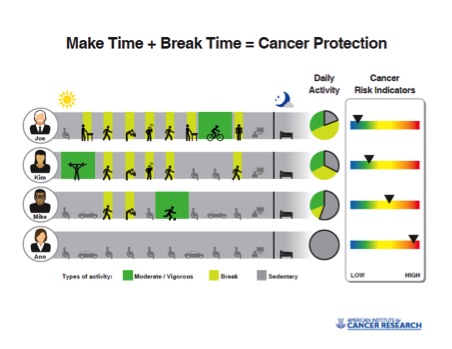By Ann Gates
(@exerciseworks)
Giving regular exercise advice and support as part of every health care consultation is fast becoming a critical health intervention in the prevention of the ‘tsunami’ of lifestyle diseases such as obesity, diabetes and related cancers. In May 2012 the U.S. Centre for Disease Control together with the Institute of Medicine released a national report detailing recommendations to combat the ‘Weight of the Nation’. The data predicted 42 percent (or 32 million more people) of the American population would be obese by 2030, while 11 percent would be severely obese. The economic costs for the associated health care services: $550 billion. This is an unsustainable cost for most health care systems and countries. This burden of lifestyle diseases and suffering is an unacceptable outcome for 21st century medicine.
The ‘Weight of the Nation 2012’ report summarised the key actions as:
- Integrating physical activity into people’s daily lives
- Making healthy food and beverage options available everywhere
- Transforming marketing and messages about nutrition and physical activity
- Making schools a gateway to healthy weights
- Galvanizing employers and health care professionals to support healthy lifestyles
Several ‘best practice’ initiatives covering both healthier diets and integrating physical activity are identified. The authors report that physical activity should be a ‘routine and integral part of daily life’.
This provides the ‘call to action’ for health professionals to lead on giving exercise advice and support to patients, relatives and caregivers on why regular exercise helps prevent and treat many lifestyle diseases or ‘non communicable diseases’ (#NCDs). 36 million people, around the world, die from lifestyle diseases each year. They are names and faces in every doctor’s waiting room, every hospital outpatient clinic and everybody’s family. This is a global health issue that needs urgent health professional intervention by every health professional around the world.
Giving physical activity advice to everyone is not as easy as it seems. We know that when doctors give exercise advice to patients that they are more likely to follow that advice (read more here). We also know that brief intervention during doctor –patient consultations is cost effective.
Exercise advice to patients should include warm up, exercise plan and cool down instructions on how to exercise effectively and safely. A weekly, balanced exercise programme for patients with chronic diseases should include cardiovascular, strength, flexibility and balance exercises. Different diseases often respond better to different types of exercises and physical activities. For example, Nordic walking or ballet has been shown to help improve the symptoms of patients with Parkinson’s disease.
Patients deserve the choice to choose how to incorporate ‘exercise as a medicine’ into their daily lives and in the prevention and management of long term diseases. Health care professionals can use tools like the American Institute for Cancer Research’s** ‘Make Time-Break Time’ infographic to help patients understand the risks of inactivity and sedentary behaviour to their health during the day. This helps patients to ‘choose’ to increase their activity levels as part of the clinical management of their health condition.

The more health professionals consult with their patients on the benefits of regular exercise and more patients start to realise the benefits to their health, the more likely health care organisations around the world can start to address the obesity and non communicable diseases epidemic in a sustainable way.
This is a call to action to change our clinical practice and implement the concept of exercise as a medicine in the prevention and treatment of chronic diseases. Exercise advice and support should be part of EVERY consultation.
It is also time for sports and exercise professionals, health care professionals and patients to work together to help improve both the weight and health of nations all around the world.
**The author apologizes to the American Institute for Cancer Research for incorrectly attributing their infographic (the necessary correction has been made).
Follow this link to see ‘part 1’ of this blog. It has 292 tweets to date – a BJSM record! Thanks everyone for promoting physical activity.
***************************************************************
Ann Gates BPharm(Hons) MRPharmS
Personal Trainer, Chronic Disease Exercise Specialist, BACPR Exercise Instructor.
Founder of Exercise Works!
email: ann@exercise-works.org